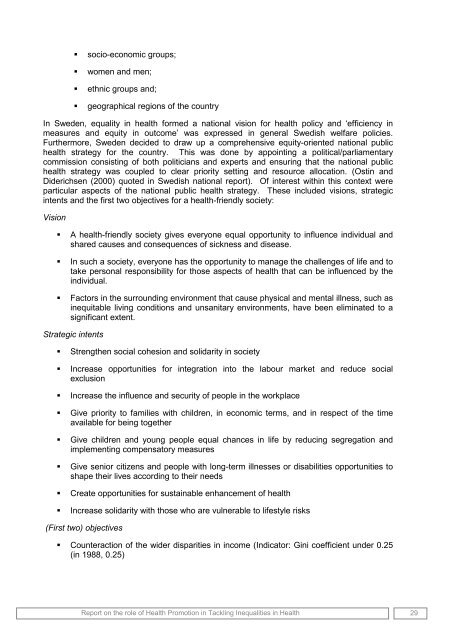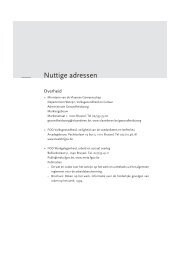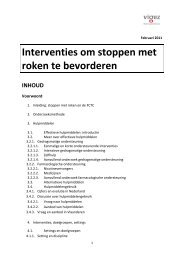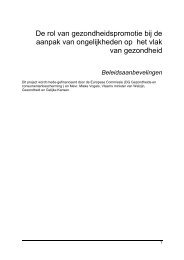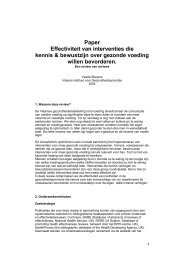Annex 1: Inventory of indicators from surveys and registries
Annex 1: Inventory of indicators from surveys and registries
Annex 1: Inventory of indicators from surveys and registries
You also want an ePaper? Increase the reach of your titles
YUMPU automatically turns print PDFs into web optimized ePapers that Google loves.
� socio-economic groups;<br />
� women <strong>and</strong> men;<br />
� ethnic groups <strong>and</strong>;<br />
� geographical regions <strong>of</strong> the country<br />
In Sweden, equality in health formed a national vision for health policy <strong>and</strong> ‘efficiency in<br />
measures <strong>and</strong> equity in outcome’ was expressed in general Swedish welfare policies.<br />
Furthermore, Sweden decided to draw up a comprehensive equity-oriented national public<br />
health strategy for the country. This was done by appointing a political/parliamentary<br />
commission consisting <strong>of</strong> both politicians <strong>and</strong> experts <strong>and</strong> ensuring that the national public<br />
health strategy was coupled to clear priority setting <strong>and</strong> resource allocation. (Ostin <strong>and</strong><br />
Diderichsen (2000) quoted in Swedish national report). Of interest within this context were<br />
particular aspects <strong>of</strong> the national public health strategy. These included visions, strategic<br />
intents <strong>and</strong> the first two objectives for a health-friendly society:<br />
Vision<br />
� A health-friendly society gives everyone equal opportunity to influence individual <strong>and</strong><br />
shared causes <strong>and</strong> consequences <strong>of</strong> sickness <strong>and</strong> disease.<br />
� In such a society, everyone has the opportunity to manage the challenges <strong>of</strong> life <strong>and</strong> to<br />
take personal responsibility for those aspects <strong>of</strong> health that can be influenced by the<br />
individual.<br />
� Factors in the surrounding environment that cause physical <strong>and</strong> mental illness, such as<br />
inequitable living conditions <strong>and</strong> unsanitary environments, have been eliminated to a<br />
significant extent.<br />
Strategic intents<br />
� Strengthen social cohesion <strong>and</strong> solidarity in society<br />
� Increase opportunities for integration into the labour market <strong>and</strong> reduce social<br />
exclusion<br />
� Increase the influence <strong>and</strong> security <strong>of</strong> people in the workplace<br />
� Give priority to families with children, in economic terms, <strong>and</strong> in respect <strong>of</strong> the time<br />
available for being together<br />
� Give children <strong>and</strong> young people equal chances in life by reducing segregation <strong>and</strong><br />
implementing compensatory measures<br />
� Give senior citizens <strong>and</strong> people with long-term illnesses or disabilities opportunities to<br />
shape their lives according to their needs<br />
� Create opportunities for sustainable enhancement <strong>of</strong> health<br />
� Increase solidarity with those who are vulnerable to lifestyle risks<br />
(First two) objectives<br />
� Counteraction <strong>of</strong> the wider disparities in income (Indicator: Gini coefficient under 0.25<br />
(in 1988, 0.25)<br />
Report on the role <strong>of</strong> Health Promotion in Tackling Inequalities in Health<br />
29


